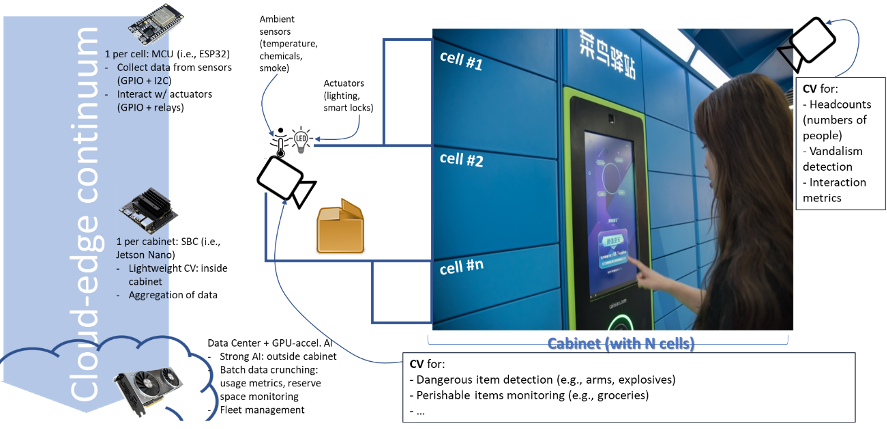On 18th October DISTINGO successfully passed the review from the Celtic-Next board and is now headed for the final stage of its development. We will now focus on getting the most advanced technologies ready and also get the needs of business users to better fine tune our use cases. You can see a video of some of our last developments in a demo here.
DISTINGO is not out for holidays: demonstrator 1 is close to ready
During this summer the DISTINGO team has continued work in implementing the recent advancements in the project’s WP3 and WP4 into a first demonstrator that can showcase progress. We have built sensors and cameras in a custom smart locker cell, based on a furniture cabinet, and we have been able to test its basic functionality, from basic data capture (temperature and other ambient sensings) as well as images captured by a camera connected to a MCU inside the cell which can interact with the Fog and Cloud levels of the architecture via wireless connection to the internet. This breakthrough will be completed in the coming weeks with advancements in the application UI for the user and other integrations to get our final prototype #1 around mid-October.

Computer vision in DISTINGO
Current Internet of Things systems often incorporate the usage of advanced AI algorithms and DISTINGO is no exception. We gather great quantities of data from our locker cabinets and cells (usage patterns, occupation, ambient physical measurements) and the images from inside the cabinet cells and the surroundings of the cabinet are no exception. We gather images and video from both sides (all in accordance to the GDPR constraints in the EU) and feed them to different algorithms for processing. The exact nature of these algorithms will evolve, but basically we want to know what is happening inside (e.g., contents of the cell, whether a dangerous item such as a weapon or bomb has been left there) and outside of the full cabinet (e.g., what’s the headcount near the cabinet, how many people approach it, detection of vandalism to teh cabinet or the surroundings). For this, we use a combination of off-the-shelf algorithms (e.g., YOLO for object recognition and openpose to detect the persons around) and extend the networks with novel approaches to detect particular activities or objects. For this we’re extensively re-training the networks to suit better DISTINGO’s needs. This will be showcased in future demonstrators and videos, so stay tuned for more information.

DISTINGO now has a working generic architecture
As part of the undergoing effort to define the building blocks of the DISTINGO system, we have worked out a system architecture that is able to collect all of the required functionality in the different levels that comprise a modern distributed IoT application: from the “edge”, where data is gathered from the locker and its surroundings to the “fog”, where light computation and data aggregation is made, all the way through to the “cloud”, where all of the data is collected, powerful AI is applied and the application resides for larger deployments. In our later documents for WP3, D3.1 and D3.2, we have proposed a complete overview of this architecture, the kind of devices that will be used and the different data that will be used.

Work Package 2 Business Models and Use Cases is now finished
We have successfully completed the last work that defines the new business models and use cases that will be part of the DISTINGO novel experience for Smart Lockers. In five confidential deliverables we have explained our new approach and all of the new use cases opened by the use of our new technologies (from IoT to computer vision) in the domain of the smart locker. Some potential use cases are depicted in the Figure and some will be chosen to showcase the project in our demonstrators in WP5.


Changes in the DISTINGO consortium
Following funding changes and company strategy decisions in the project start-up, DISTINGO has streamlined the consortium to just HI Iberia (Spain, coordinators), Quobis Networks (Spain) and BEIA Consult (Romania). With this, we lose some of our strength and market proximity but we gain in agility. The general goals of the project and overall timeline is maintained and Celtic Plus still is confident in the project’s chances of success.
DISTINGO Project kick-off meeting held in Madrid
On December 18th a face to face meeting was held at the premises of new coordinators HI Iberia to kick-off the activities in Celtic-Plus project DISTINGO. All national consortia sent representatives and the Spanish cluster was fully represented. During the meeting, several managerial topics were undertaken, the most important of which was the selection of a new coordinator as Orange Labs had to withdraw from the project. The incoming coordinator will be Raúl Santos de la Cámara from HI Iberia, in substitution of David Excoffier. In the coming months the rest of the reorganization of the Project will be completed to accommodate the changing partners in the consortium.

